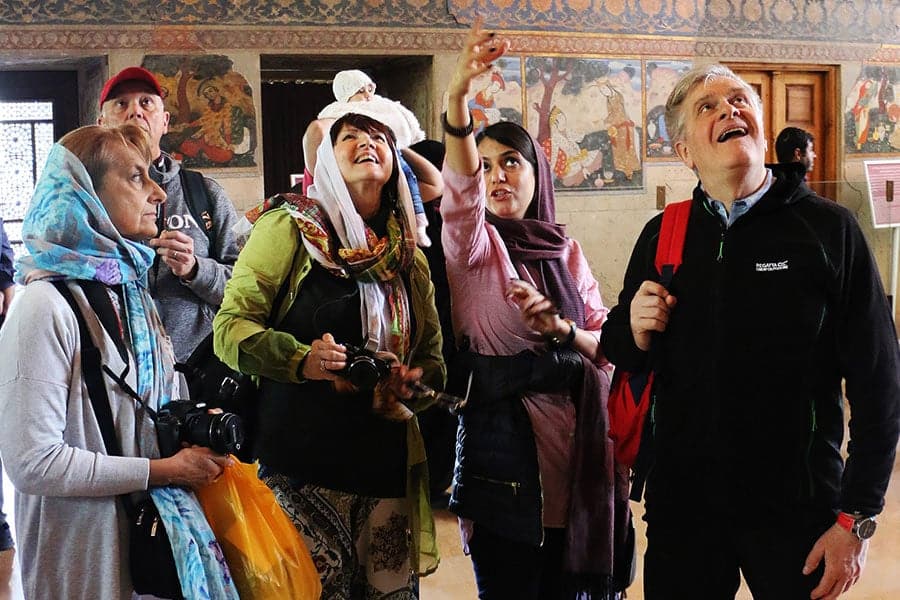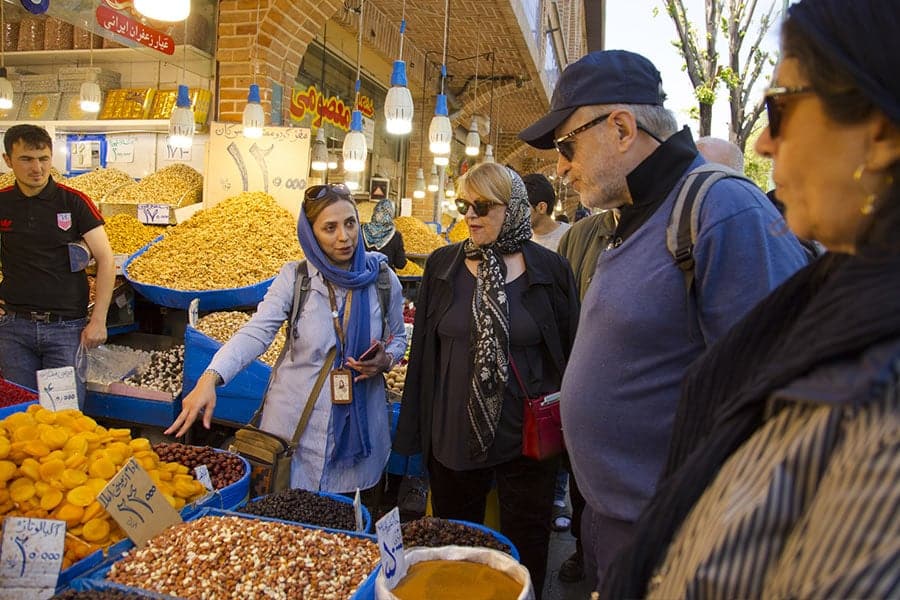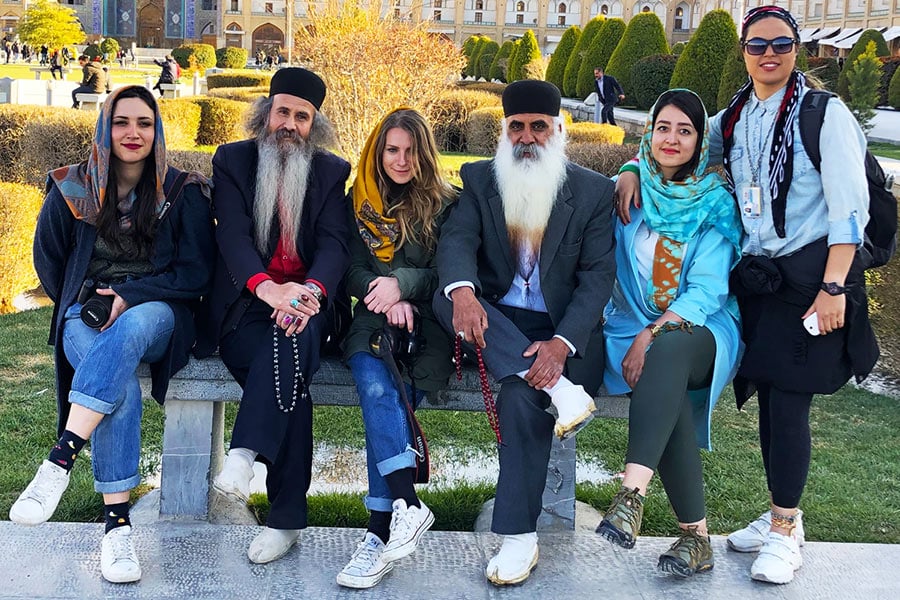Bisotun Travel Guide: An Adventure in the Land of Lost Kings
Discover Bisotun's ancient wonders in this essential guide

Step into the ancient world of Bisotun, Iran’s historic marvel. Home to the famed bas-relief and inscription of Darius I, this UNESCO World Heritage site bridges the gap between the present and the empire’s majestic past.
Bisotun offers a unique glimpse into the Achaemenid Empire, showcasing art, language, and the power dynamics of ancient Persia. Ideal for history enthusiasts and travelers alike, Bisotun reveals the enduring legacy of one of history’s greatest civilizations. Discover the secrets of ancient Persia in a journey through time at Bisotun.
Contents
Significance and Location
Bisotun is not merely a location; it’s a bridge between the past and present. Situated along a vital ancient trade route that once connected the Persian high plateau with Mesopotamia, its strategic position made it a focal point for cultural, political, and economic exchanges.
The area’s most famous feature, a bas-relief and cuneiform inscription created under the order of King Darius I in 521 BC, marks a pivotal moment in the history of the Persian Empire and the broader region.
This site, enveloped in the rugged landscape of the Zagros Mountains, offers a glimpse into the complex dynamics of ancient empire-building, resistance, and communication.
Importance in Archaeology and History
The significance of Bisotun extends beyond its visual impact. It serves as a key to unlocking the mysteries of ancient civilizations. The cuneiform inscriptions found here provided scholars with critical insights into Old Persian, Elamite, and Babylonian languages, much like the Rosetta Stone did for Egyptian hieroglyphs. These inscriptions have allowed historians to piece together the events that shaped the Achaemenid Empire and understand the ideological and theological underpinnings of Darius I’s rule.

Moreover, Bisotun’s contribution to archaeology and history is unparalleled. The site encompasses remnants from various eras, from prehistoric times through the Median, Achaemenid, Sassanian, and Ilkhanid periods, offering a continuous narrative of human occupation and cultural evolution. Its designation as a UNESCO World Heritage Site underscores its global importance, safeguarding its legacy for future generations to study and admire.
The History of Bisotun
Bisotun’s story is a remarkable journey through time, showcasing human resilience, innovation, and the quest for understanding. This site has witnessed the ebb and flow of civilizations, each leaving an indelible mark on the fabric of history.
Early Settlements and Prehistoric Significance
The roots of Bisotun stretch deep into prehistory, with evidence of human activity dating back thousands of years. These early settlements reveal the strategic and cultural importance of the site, situated on a vital communication and trade route.

Archaeological findings, including tools and artifacts, tell tales of early human ingenuity and adaptation. The presence of water sources and fertile land made Bisotun an ideal location for settlement, marking it as a cradle of civilization in the ancient world.
The Median Period and Its Contributions
The Median era heralded the rise of a powerful dynasty that would lay the groundwork for the empires to come. Bisotun, during this period, emerged as a significant center, reflecting the Medes’ architectural and administrative advancements. Though less is known about the specifics of their contributions at Bisotun, the Medians set the stage for the monumental developments that would follow under the Achaemenid Empire. Their legacy is embedded in the region’s cultural and historical tapestry, serving as a bridge between the prehistoric past and the classical antiquity.
The Achaemenid Empire’s Influence and Darius I’s Legacy
The Achaemenid period marks the zenith of Bisotun’s historical and cultural significance. King Darius I‘s monumental inscription and bas-relief stand as a testament to the empire’s power, sophistication, and administrative acumen.

This narrative carved in stone, detailing Darius’s conquests and consolidation of the Persian Empire, is a masterpiece of ancient propaganda and art. It not only celebrated Darius’s victories but also served as a warning to potential usurpers. The use of multiple languages in the inscriptions demonstrated the empire’s diversity and Darius’s control over its vast territories, from the Indus Valley to the Aegean Sea.
Post-Achaemenid and Sassanian Periods
Following the fall of the Achaemenid Empire, Bisotun continued to play a pivotal role in the region’s history. The site saw further developments during the Sassanian era, reflecting the shifting dynamics of power and culture in ancient Persia. The Sassanians, renowned for their military prowess and architectural achievements, added their layer to the historical narrative of Bisotun, illustrating the continuity of settlement and the site’s enduring importance.

Throughout the post-Achaemenid and Sassanian periods, Bisotun remained a symbol of imperial power and cultural achievement. Its rich history, spanning from prehistoric times through successive empires, underscores the site’s unparalleled significance in understanding the complexities of ancient civilizations.
Exploring the Bas-relief and Inscription
The bas-relief and inscription at Bisotun constitute one of the most compelling narratives from the ancient world, intricately carved into the limestone cliff. This section dives into the artwork’s imagery, its historical importance, and the linguistic breakthrough it provided.
Detailed Description of the Bas-relief Imagery
At the heart of the Bisotun relief is King Darius I, depicted with a bow in hand, symbolizing his sovereignty and divine right to rule. The king stands over a prostrate figure, believed to be Gaumāta, the usurper, symbolizing Darius’s triumph over rebellion. Surrounding these central figures are nine captives, tied and awaiting their fate, representing the conquered rebels from various regions of the empire. This vivid portrayal not only celebrates Darius’s victory but also serves as a visual assertion of his power and the order he restored across the Persian Empire.
Deciphering Bisotun’s Inscription

The decipherment of the Bisotun inscription in the 19th century stands as a landmark achievement in the field of Assyriology, opening a window into ancient Persian history and language that had been closed for millennia. This breakthrough parallels the significance of the Rosetta Stone for Egyptian hieroglyphs, offering crucial keys to understanding ancient texts.
The Story of Its Decipherment in the 19th Century
The journey to decipher the Bisotun inscription was a feat of linguistic and historical detective work. Spearheaded by British officer Sir Henry Rawlinson, the process involved perilous climbs to access the inscriptions and meticulous comparisons of the cuneiform scripts. Rawlinson, who had a keen interest in the ancient languages of the region, spent several years in the mid-1800s studying the inscriptions. His breakthrough came when he successfully deciphered the Old Persian section, a feat that laid the groundwork for understanding the Elamite and Babylonian portions of the text. This achievement unlocked the history of the Persian Empire as told by Darius I himself, shedding light on its politics, society, and culture.
Its Comparison to the Rosetta Stone
Much like the Rosetta Stone, which provided the key to deciphering Egyptian hieroglyphics, the Bisotun inscription’s decipherment was pivotal for the study of ancient Near Eastern languages. The Rosetta Stone featured the same text in three different scripts (Greek, Demotic, and hieroglyphics), allowing scholars to cross-reference and eventually crack the code of hieroglyphics. Similarly, the multilingual texts of Bisotun, written in Old Persian, Elamite, and Babylonian, enabled linguists to compare and decode these cuneiform scripts. Both discoveries represent monumental milestones in archaeology, opening up vast new areas of ancient history for exploration and understanding.
Contributions to Assyriology and Ancient History
The decipherment of the Bisotun inscription has had far-reaching impacts on the field of Assyriology and the study of ancient civilizations. By providing a direct account of Darius I’s reign and the early Persian Empire, it has enriched our understanding of ancient political structures, cultural practices, and linguistic development. Furthermore, the inscription has been crucial in piecing together the timeline of ancient Near Eastern history, contributing to the broader comprehension of how these civilizations interacted, evolved, and influenced each other across millennia.

Significance of Darius I’s Cuneiform Inscription
The cuneiform inscription at Bisotun is more than just an ancient text; it’s a groundbreaking document that shed light on the history, politics, and languages of the ancient Near East. Commissioned by Darius I following his consolidation of power, the inscription outlines his ascension to the throne, the rebellions he faced, and his subsequent victories. This monumental text serves as a declaration of legitimacy and divine support, intended to be read by gods and men alike. Its significance extends beyond its historical narrative, marking a pivotal moment in the understanding and use of written language to convey political power and ideology.
The Languages of the Inscription: Old Persian, Elamite, and Babylonian
The inscription’s multilingual approach was a strategic decision by Darius, designed to communicate his message across the diverse empire. The text is presented in Old Persian, Elamite, and Babylonian — three significant languages of the time, each catering to a different audience within the empire. This linguistic diversity not only underscores the Achaemenid Empire’s vastness but also its multicultural nature. The use of Old Persian, in particular, highlights the rise of Persian culture and language during Darius’s reign.
The decipherment of these texts in the 19th century marked a significant achievement in the field of Assyriology, akin to the decipherment of Egyptian hieroglyphs by the Rosetta Stone. The Bisotun inscription has thus been instrumental in advancing our understanding of ancient languages and civilizations, providing an invaluable window into the past.
Archaeological Discoveries at Bisotun

The archaeological investigations at Bisotun have uncovered a wealth of artifacts and insights, revealing the extensive history and cultural developments of this site through various eras. These discoveries not only highlight Bisotun’s significance in the ancient world but also its continued relevance to our understanding of human history.
Excavations and Findings
Archaeologists have painstakingly explored Bisotun, unearthing objects that span from the prehistoric periods to the post-Achaemenid and Sassanian eras. Among the significant findings are pottery, tools, and remnants of structures that provide evidence of the site’s long-standing occupation and strategic importance. The excavation of these items offers a glimpse into the daily lives, trade practices, and artistic expressions of the people who once inhabited this area. Each artifact serves as a clue, piecing together the complex puzzle of Bisotun’s past.
The Site’s Timeline Through Different Eras
The timeline of Bisotun reflects a rich tapestry of human occupation and cultural evolution. Starting from the prehistoric times, evidence suggests that the site was a hub of activity, benefiting from its strategic location and natural resources. Moving into the Median period, Bisotun became part of a growing empire, contributing to the development of military and architectural innovations.
The Achaemenid Empire marked the pinnacle of Bisotun’s significance, with King Darius I’s monumental inscription and bas-relief symbolizing the empire’s power and the king’s divine legitimacy. This period solidified Bisotun’s role as a key political and cultural center in the ancient world.
Following the Achaemenid era, the site continued to evolve through the Sassanian period and beyond, each phase adding layers to its historical and cultural landscape. The Sassanians, known for their military might and architectural prowess, left their mark, underscoring the site’s enduring importance across centuries.
Visiting Bisotun: A Travel Guide
Embark on a journey to Bisotun, an iconic historical site in western Iran, where ancient stories are carved into the limestone cliffs. This travel guide will provide you with all the necessary details, mimicking the depth and thoroughness of sources like Lonely Planet and Wikitravel, to ensure a memorable visit.
How to Get There

By Air: The nearest major airport to Bisotun is in Kermanshah, offering domestic flights from major Iranian cities. From Kermanshah, you can hire a taxi or take a local bus to reach Bisotun, which is approximately 30 kilometers away.
By Road: Bisotun is accessible by road from Tehran and other major cities. The drive from Tehran takes around 5 to 6 hours on the Tehran-Kermanshah highway, providing travelers with scenic views of the Zagros mountains. Rental cars, buses, and private taxis are available options for this journey.
By Rail: Kermanshah is also connected to major cities like Tehran by rail. Traveling by train offers a comfortable and scenic route to the region. From Kermanshah’s railway station, continue your journey to Bisotun via road.
Best Times to Visit
The best times to visit Bisotun are during the spring (March to May) and fall (September to November) months. During these periods, the weather is mild, and the natural landscape around Bisotun is at its most vibrant, enhancing the overall experience of the historical site. Summers can be quite hot, making exploration less comfortable, while winters are cold, which might not suit every traveler.
Tips for Tourists
- Dress Appropriately: Considering Bisotun’s location in Iran, it’s important to dress conservatively, respecting local customs. This is especially relevant for female travelers.
- Hire a Guide: To fully appreciate the historical context and significance of the Bisotun inscriptions and reliefs, consider hiring a local guide. Many guides are knowledgeable about the site’s history and can provide insights that you might not find in guidebooks.
- Stay Hydrated: The area can be warm, particularly outside the spring and fall seasons. Carry water with you as you explore the expansive site.
- Respect the Site: Bisotun is a UNESCO World Heritage Site with significant archaeological importance. Avoid touching the inscriptions and reliefs to help preserve them for future generations.
- Photography: Bring your camera or smartphone. The site offers stunning visuals that you’ll want to capture. However, be mindful of any restrictions on photography, especially of the bas-reliefs and inscriptions.
- Plan for Walking: Wear comfortable shoes as there’s a fair amount of walking involved to fully explore the site. The terrain can be uneven in places, so appropriate footwear will enhance your experience.
- Accommodation: While there are no accommodations directly at Bisotun, nearby Kermanshah offers a range of options from budget-friendly hotels to more luxurious stays. Booking in advance is recommended, especially during the peak travel seasons of spring and fall.
Book Services, Pay Online
Preservation Efforts and UNESCO Heritage Status
The preservation of Bisotun has become a focal point for both Iranian authorities and international conservation organizations. Recognizing its invaluable contribution to humanity’s cultural and historical heritage, Bisotun was designated a UNESCO World Heritage Site, a testament to its global significance and the urgent need for its protection.

Conservation Projects
A series of conservation projects have been initiated to safeguard Bisotun’s integrity against the threats of erosion, environmental damage, and human interference. These efforts include:
- Structural Stabilization: Measures to stabilize and restore the physical structure of the bas-relief and surrounding archaeological features, ensuring they remain intact for future generations.
- Environmental Management: Strategies to manage the site’s surrounding environment, protecting it from natural and human-caused deterioration.
- Documentation and Research: Comprehensive documentation of the site’s inscriptions, reliefs, and archaeological findings to facilitate research and educational projects.
- Public Awareness: Programs designed to educate the public and local communities about the importance of preserving Bisotun and its history, fostering a sense of stewardship and respect for the site.
Recognition and Global Significance
The UNESCO Heritage status of Bisotun highlights its recognition on a global scale, underscoring the site’s universal value as a cultural landmark. This designation not only brings international attention to Bisotun but also encourages a collaborative approach to its preservation, involving experts, scholars, and conservationists from around the world.
The global significance of Bisotun lies in its unparalleled historical, linguistic, and artistic contributions, offering insights into the ancient Persian Empire and the broader cultural exchanges of the ancient Near East. By preserving Bisotun, we maintain a vital link to our shared past, allowing current and future generations to learn from and be inspired by its enduring legacy.

Conclusion: The Legacy of Bisotun
The significance of Bisotun in history and culture is profound. From its inception in early settlements, through the Median era, to the peak of the Achaemenid Empire and its influence in subsequent periods, Bisotun has been a pivotal center of power, art, and communication. The grand bas-relief and cuneiform inscription commissioned by Darius I epitomize ancient Persian impact, demonstrating the empire’s advanced governance, artistic expression, and ability to convey powerful messages.
Additionally, the site’s contributions to monumental art and the breakthroughs in understanding cuneiform scripts underscore its critical role in archaeological and linguistic research. Its designation as a UNESCO World Heritage site underscores its global importance, marking it as a beacon of our collective heritage.
Read More














